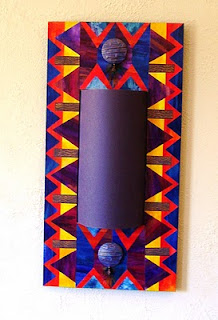Solving the Problem, Part One: Mirrors
Many years ago, when I was working in textbook publishing art direction, a designer whose work I admired said something which has stuck with me ever since. He said that he approached design as the way to solve a problem. Simple to say, often difficult to execute.
In my own work, I approach design, especially when I'm contemplating a new product or series of products just this way.
When I first began creating mirrors, I used IKEA 10"x10" unfinished wood mirrors as the bases. They were readily available (after a 4-hour drive to Potomac Mills), cheap, lightweight, and easy to work with. Problem to solve: how to work within the confines of the 10x10 fomat and make something so cheap and generic look well-desgined?

 When, after about 4 years of using these mirrors, we found they began to separate along the glued seams. These separations were unfixable, which meant that all my work on them went down the drain. Problem to solve: find another substrate which won't split. Stan suggested MDF, which is a solid surface, doesn't warp, and has the added bonus of being both a 'green' product and one we can manipulate to our own specifications. So, we now use MDF exclusively, and are able to have a variety of sizes and shapes. Problem to solve: how to design for all of these new variations? And within that problem, there's another: how to make each piece a unique expression of my creativity? And within that problem, there's yet another: how to make my creative vision something which appeals to people enough to want to have it in their homes? Here are some of my MDF solutions, in 8"x10", 10"x16", and 12"x 24" sizes. Design and problem-solving for me are ongoing processes.
When, after about 4 years of using these mirrors, we found they began to separate along the glued seams. These separations were unfixable, which meant that all my work on them went down the drain. Problem to solve: find another substrate which won't split. Stan suggested MDF, which is a solid surface, doesn't warp, and has the added bonus of being both a 'green' product and one we can manipulate to our own specifications. So, we now use MDF exclusively, and are able to have a variety of sizes and shapes. Problem to solve: how to design for all of these new variations? And within that problem, there's another: how to make each piece a unique expression of my creativity? And within that problem, there's yet another: how to make my creative vision something which appeals to people enough to want to have it in their homes? Here are some of my MDF solutions, in 8"x10", 10"x16", and 12"x 24" sizes. Design and problem-solving for me are ongoing processes.Next up: Solving the Problem, Part Two: Clocks




Comments